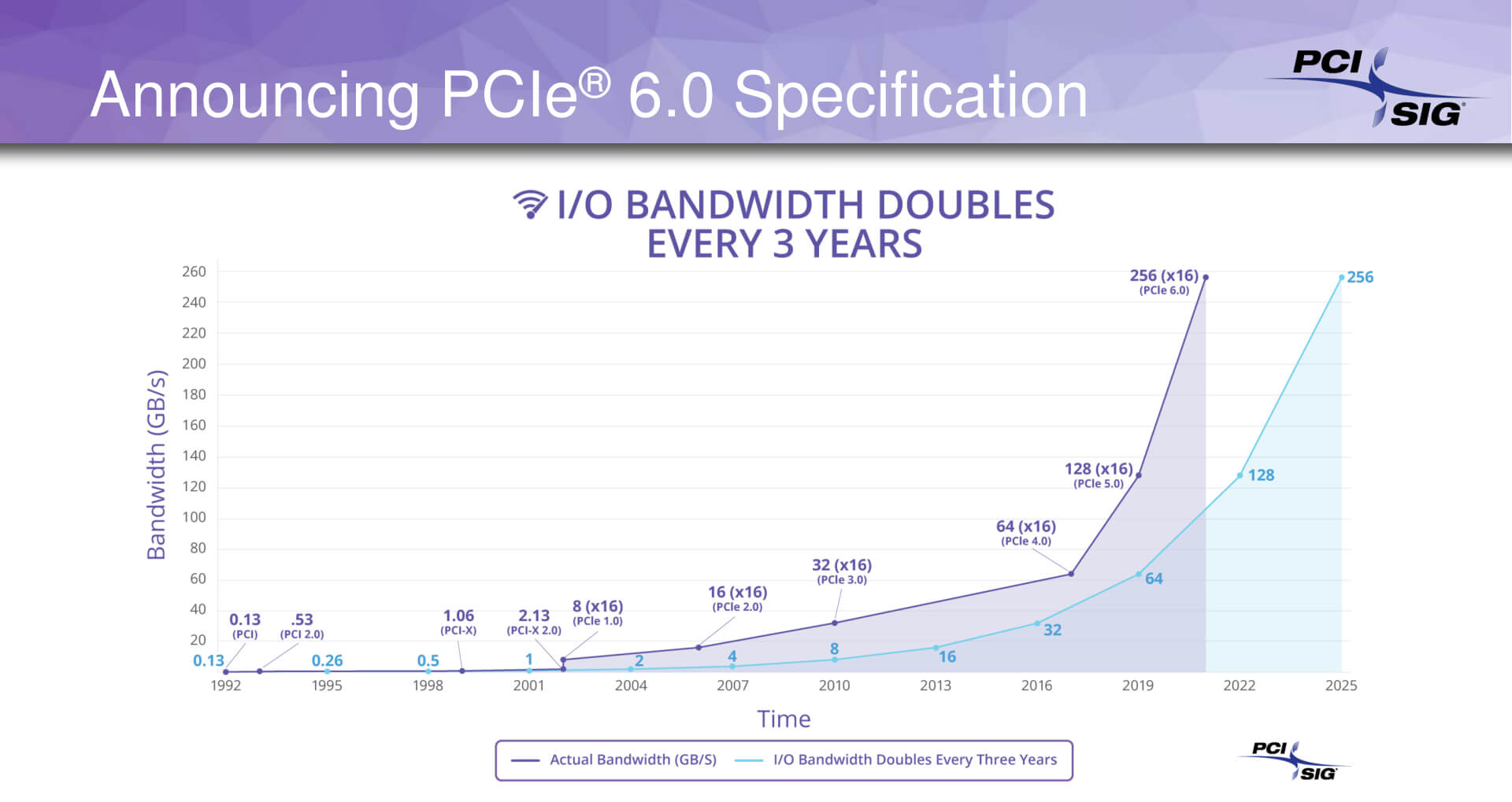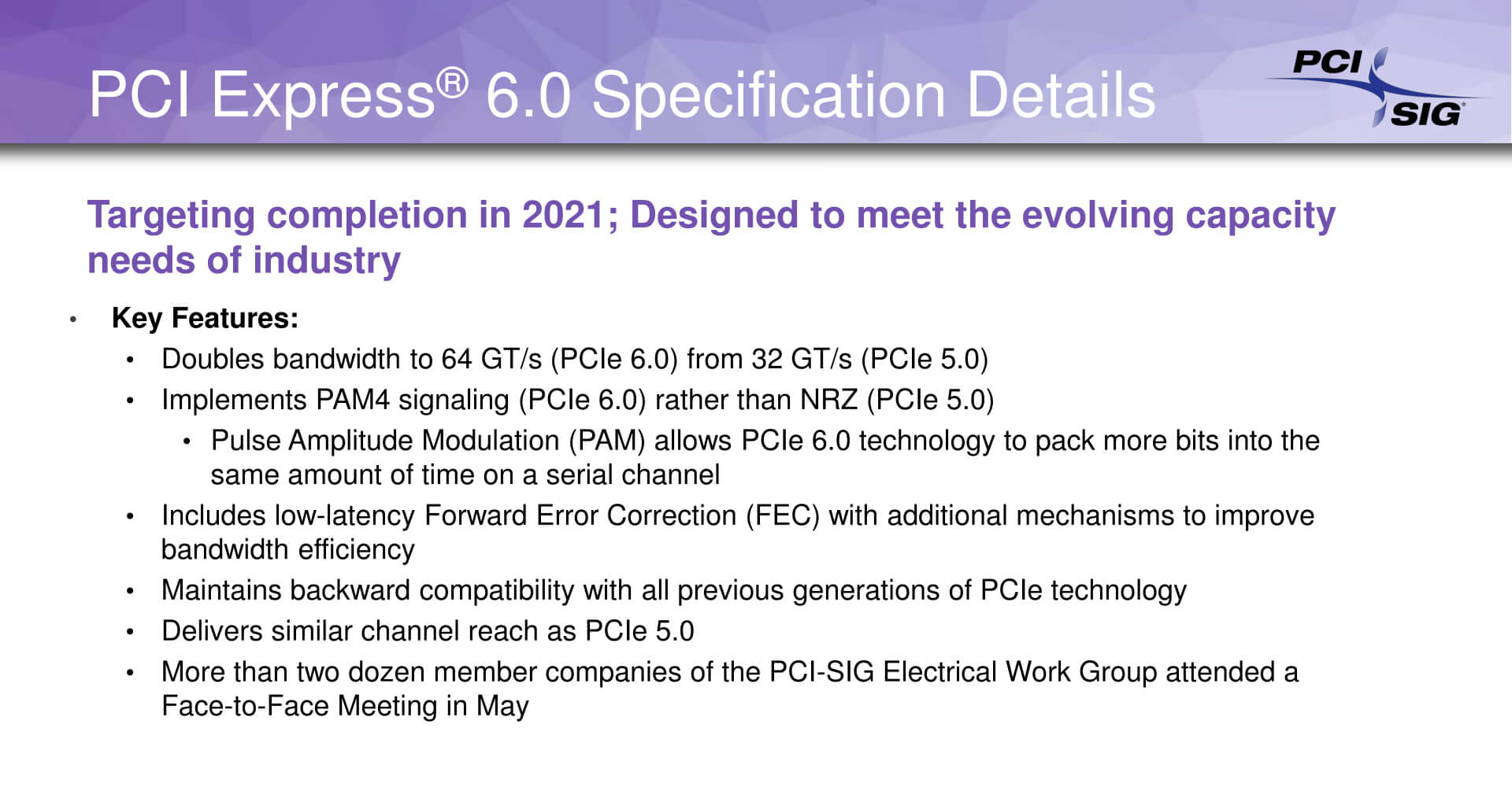PCIe 6.0 spec announced with 256GB/s transfer speeds, twice that of 5.0
What just happened? The PCI-SIG (Peripheral Component Interconnect Special Interest Group) has just announced the PCIe 6.0 specification. That’s rather quick given that PCIe 5.0 specs were made public just a month ago. And it’s way ahead of the market adoption rate for PCIe 4.0 for which consumers have just started to get excited about.
Motherboard manufactures will have lots of hardware added to their pipeline as PCIe 6.0 specifications were announced yesterday at the PCI-SIG Developers Conference 2019. The successor to PCIe 5.0 revealed last month looks to double transfer speeds with 256GB/s transfers. This quadruples the speed of PCIe 4.0 hardware that’s just started to make its way to consumers.
Given its history, the industry standard usually takes around a year between its announcement and market availability of supported hardware. With PCIe 5.0 unlikely to arrive until 2020 at the earliest, the consortium expects PCIe 6.0 to finalize by 2021 after which consumers can expect to see supported hardware in 2022 or 2023.
“Continuing the trend we set with the PCIe 5.0 specification, the PCIe 6.0 specification is on a fast timeline,” said Al Yanes, PCI-SIG Chairman and President. “Due to the continued commitment of our member companies, we are on pace to double the bandwidth yet again in a time frame that will meet industry demand for throughput.”
The PCIe 6.0 spec is targeted at evolving industry needs which will greatly benefit AI accelerated applications, NVMe storage and of course, GPUs.
By: Techspot
Microsoft could replace little-used key with a dedicated Office key on keyboards
Forward-looking: Are you a regular user of Microsoft’s Office products? If so, then this will probably be of interest: the Redmond company is debating whether to add a dedicated Office button to keyboards, possibly replacing another key.
The news comes from an internal Microsoft survey first spotted by prolific leaker WalkingCat. It appears the Office key would replace either the second Windows key on the right side of a keyboard or the dedicated Menu key, both of which are rarely used by most people.
The survey asks if the participant has tried a keyboard with the Office key on a PC running the Windows 10 May 2019 Update version 1903, and how Microsoft could improve the experience.
There’s mention of its shortcuts—Office key + O, T, W, X, P, D, N, Y, and L—which presumably launches Outlook, Teams, Word, Excel, Powerpoint, etc., and whether users would like to see extra shortcuts added, such as Office key + S to share a document.
Respondents are asked to rate the Office key concept out of five and whether they would like to see it appear on a laptop.
Whether people would get much use out of a dedicated Office key is open to debate, but in some cases it will probably be used more often than the secondary Windows key or Menu key. This is still classed as a concept, so we’ll have to wait and see if Microsoft decides it’s something users want.
By: Techspot
Samsung TV’s
Samsung released a 146 inch TV last year and now a 219 inch TV. There is also cooler, new technology in the TV’s this year. The frame has been updated to look sleeker. They also updated the 65, 75 and 82 inch screens to QLED 8k resolution. 8K resolution will be the clearest, sharpest image ever released by Samsung. These TV’s also adapt to their surroundings by changing color. These are great ways to transform any space. With TV’s becoming for cost effective every day, one of these TV’s would be a home run. Here is a link with more info:
Teenager says he hacked Apple hoping it would hire him
Facepalm: Many people have ambitions of working for Apple, but there are right ways and wrong ways to go about it. Hacking into the company, twice, and being arrested for your crimes isn’t the best way to secure employment, but an Australian teenager thought it was a good plan.
In fairness to the teen, who can’t be named for legal reasons, he’d heard that Apple hired a European hacker who’d broken into its systems, so he assumed the company would also offer him a job for doing something similar.
The 17-year-old, along with another teen, hacked Apple in 2015 when he was just 13 and again in 2017 by creating false credentials to break into the company’s servers. They downloaded internal documents and data but no customer information was compromised and Apple was not harmed financially or intellectually, according to the court.
“He had no idea about the seriousness of the offence and hoped that when it was discovered that he might gain employment at this company,” his lawyer, Mark Twiggs, told the Adelaide Youth Court.
Rather than being convicted, the teen was given a $500 (around $346 US) 9-month good behavior bond and was told to use his skills for good.
The accomplice in the case, who is now 19, also avoided jail, receiving an 8-month good behavior bond. It was last year reported that after a warrant was executed on the second boy’s family home, the stolen information was discovered on a hard drive in a folder called “Hacky hack hack.” His lawyers said he also dreamed of working for the Cupertino company one day—maybe applying the traditional way would be better, and certainly less risky.
By: Techspot
Firefox issues emergency patch for a zero day flaw already being exploited in the wild
What just happened? Browser vulnerabilities are a common occurrence and don’t usually pose a serious threat since regular software updates tend to include security fixes to patch these flaws, unless it’s a rare zero-day bug. Mozilla’s Firefox, one of the most popular browsers out there, recently issued an update to address a critical zero day vulnerability that its engineers acknowledge has already been exploited in the wild.
Users running Mozilla’s Firefox browser are strongly advised to update to its latest version 67.0.3, recently released by the Mozilla team to address a zero-day vulnerability that’s currently being abused in the wild.
In its security advisory, the company states the bug’s impact as critical. “A type confusion vulnerability can occur when manipulating JavaScript objects due to issues in Array.pop,” Mozilla describes it in the post. “This can allow for an exploitable crash. We are aware of targeted attacks in the wild abusing this flaw.”
The bug find is credited to security researcher Samuel Groß of Google Project Zero and the Coinbase Security team. It’s assumed that the vulnerability is being exploited to attack cryptocurrency owners, considering where the bug report originated from. Hype around cryptocurrency has risen these past few days, with Facebook officially announcing its own entry this week.
Updating Firefox is pretty straightforward. You can download the latest version here, though the browser is set to automatically update by default.
You can also check manually by typing “Update” in the search bar and press the “Restart to update Firefox” button or use the Menu bar at the top and go to Help > About Firefox to trigger an update.
By: Techspot
Intel, Microsoft, HP, and Dell unite against proposed tariffs on Chinese imports
What just happened? It’s not often that we see tech companies unite to take a stand against something, but Intel, HP, Microsoft, and Dell have joined forces to object to the Trump administration’s proposed tariffs on $300 billion of Chinese goods, which includes laptops and tablets.
As reported by Bloomberg, the four tech giants have submitted joint comments opposing the tariff escalation. They believe such actions would hurt consumers that purchase the goods and the industry as a whole, while failing to address China’s trade practices.
“The tariffs will harm U.S. technology leaders, hindering their ability to innovate and compete in a global marketplace,” the companies wrote in comments posted online.
The news comes just days after a study commissioned by the Consumer Technology Association (CTA) predicted US price rises for several electronic goods if the new tariffs are imposed. Laptops are thought to be one of the areas most affected, with the current national average price jumping from $622 to $742, partly because China accounts for 90 percent of total laptop/tablet imports.
The companies say it will be “cost-conscious customers” who are hit hardest by the tariffs, adding that at best, they would continue using older laptops without security features. At worst, the high prices would force these consumers to go without laptops altogether. “School districts, in particular, operate on fixed budgets that cannot accommodate substantial price increases,” the firms wrote. They added that the tariffs could also inhibit innovation, productivity, and job creation.
The government is hearing public comments on the proposed duties up until June 25.
In more optimistic news, Trump and Chinese President Xi Jinping are set to meet at the G20 Summit in Japan next week in the hope of relaunching trade talks.
By: Techspot
 Toll Free: 888-88-CADAN
Toll Free: 888-88-CADAN Support
Support Client Login
Client Login



